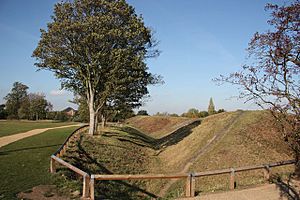Sconce and Devon Park facts for kids
Sconce and Devon Park is a cool park in Newark, England. It's famous for being home to the Queen's Sconce, which is a really old earthwork fort. This fort was built way back in 1646 during the First English Civil War. Its job was to protect the soldiers of King Charles I who were based at Newark Castle. Today, the Queen's Sconce is a special ancient monument. The park also has a visitor centre, a local nature reserve, and is part of a fun civil war trail that goes through the town.
Contents
What Can You Do at Sconce and Devon Park?
Sconce and Devon Park has lots of space to explore! You'll find big open grassy areas and lovely woodlands, including the Devon Pastures Local Nature Reserve. It's a great place for families with a children's play area. If you're interested in history, you can follow the civil war trail.
Park Activities and Features
The park has a cafe where you can grab a snack. For sports fans, there's a football centre with pitches for both adults and mini-soccer. Park rangers are often around to help or answer questions. You can also use the fitness trail to get some exercise. There's a peaceful wildlife pond to observe nature.
Running Events
If you like to run, a parkrun happens every Saturday morning at 9 am. There's also a junior parkrun every Sunday at 9 am, perfect for younger runners!
Nature and Wildlife
The River Devon flows right past the park. It's home to different kinds of fish like perch, bream, pike, chubb, and carp. The woodlands have beautiful trees such as English Oak, willow, and English Elm. There are also two meadows that are part of the Local Nature Reserve, full of different grasses and marsh plants. An orchard in the park grows damson, blackthorn, plum, and apple trees.
The Queen's Sconce: A Civil War Fort
During the First English Civil War, Newark-on-Trent was a very important town for the Royalists (supporters of the King). It was a key location because it was the last place to cross the River Trent. It also sat where two major roads, the Great North Road and Fosse Way, met. This made it a very important stronghold.
Newark's Role in the War
The main fort in Newark was Newark Castle. The town was attacked and surrounded three times by the Parliamentarian army. Finally, in May 1646, King Charles I told his soldiers to surrender. These attacks, called sieges, led to many defensive structures being built by both sides.
How the Queen's Sconce Was Built
The second siege of Newark showed that the town's defenses weren't strong enough. So, two new earthwork forts were built. One was the Queen's Sconce, and the other was the King's Sconce. The Queen's Sconce was built on a small hill. It was placed there to protect the town from attacks coming from the south. It was named after King Charles I's wife, Henrietta Maria of France.
Why the Sconce Still Stands
The Queen's Sconce is one of the few forts from that time that still exists today. It was left untouched because the winning Parliamentarian army quickly left the area. They were afraid of the plague. The Sconce is quite large, measuring about 120 meters by 133 meters. Its walls can be up to 9 meters high.
Sconce Design and Features
The fort has angled bastions (parts that stick out) on its south, southwest, north, and northeast corners. These corners were likely platforms for firing cannons. The main walls, called ramparts, and the bastions are surrounded by a wide ditch. This ditch is up to 21 meters wide and 3.6 to 4.5 meters deep. There's also a small bank, about 0.7 meters high, along the edge of the ditch. This bank shows where a palisade (a fence of strong wooden stakes) once stood. Old records suggest this wooden fence originally went all around the Sconce. The fort was built using gravel from the River Devon. If you look at it from above, it has a cool star shape!



